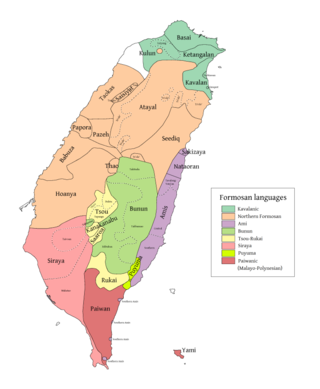Basay language
| Basay | |
|---|---|
| Ketagalan | |
| Native to | Taiwan |
| Ethnicity | Basay, Qauqaut |
| Extinct | mid-20th century |
Language family | Austronesian
|
| Dialects |
|
| Language codes | |
| ISO 639-3 | byq |
Linguist List | byq.html |
| Glottolog | basa1287 |
 (dark green, north) The Kavalanic languages: Basai, Ketagalan, and Kavalan | |
Basay was a Formosan language spoken around modern-day Taipei in northern Taiwan by the Basay, Qauqaut, and Trobiawan peoples. Trobiawan, Linaw, and Qauqaut were other dialects (see East Formosan languages).
Basay data is mostly available from Erin Asai's 1936 field notes, which were collected from an elderly Basay speaker in Shinshe, Taipei, as well as another one in Yilan who spoken the Trobiawan dialect (Li 1999). However, the Shinshe informant's speech was heavily influenced by Taiwanese, and the Trobiawan informant, named Ipai, had heavy Kavalan influence in her speech.
Li (1992) mentions four Basaic languages: Basay, Luilang, Nankan, Puting.[1] Nankan and Puting are close to Kavalan, whereas Luilang is divergent.[2]
Syntax
There are four optional case markers in Basay (Li 1999:646).
- a – nominative, ligature (Shinshe dialect)
- ta – nominative (Trobiawan dialect)
- li – locative (Shinshe dialect)
- u – oblique (Trobiawan dialect)
Some function words include (Li 1999):
- pai 'future'
Trobiawan negators include (Li 1999):
- mia 'not' (Shinshe dialect: mayu 'not (yet)')
- asi 'don't' (Shinshe dialect: manai 'don't')
- (m)upa 'not to want'
- (Shinshe dialect: kualau 'not exist')
Yes–no questions are marked by u ~ nu (Li 1999:657).
Morphology
Basay verbs, like Kavalan verbs, distinguish between agent-focus (AF) and patient-focus (PF) verbs (Li 1999:650). The perfective prefixes na- and ni- are allomorphs.
| Type of prefix | Neutral | Perfective | Future |
|---|---|---|---|
| Agentive focus (AF) | -um-, m- | na-mi- | -um- ... -a, m- ... -a |
| Patient focus (PF) | – | ni- | -au |
| Locative focus (LF) | -an | ni- ... -an | -ai |
Pronouns
The Basay pronouns below are from Li (1999:639).
| Neutral | Nominative | Genitive | Oblique | |||
|---|---|---|---|---|---|---|
| 1st person | singular | yaku | kaku, -ku | maku-, -aku; naku, -ak | yakuan, kuan, kuanan | |
| plural | excl. | yami | -mi | yami, -ami; nami, -am | yamian, mian, mianan | |
| incl. | mita | kita, -ita | mita, -ita; nita, -ta | ... , ... , tianan | ||
| 2nd person | singular | isu | kisu, -su | misu, -isu; nisu, -su ~ -is | isuan, suan, isuanan, suanan | |
| plural | imu | kimu, -mu | -imu; nimu, -im | imuan, ... , imuanan | ||
| 3rd person | singular | – | -ia | – | – | |
| plural | – | -ia | – | – | ||
References
Notes
- ^ Li, Paul Jen-kuei (2001). "The Dispersal of the Formosan Aborigines in Taiwan" (PDF). Language and Linguistics / Yǔyán jì yǔyánxué. 2 (1): 271–278. Archived from the original (PDF) on 2020-08-08. Retrieved 2021-06-30.
- ^ Tsuchida, Shigeru. 1985. Kulon: Yet another Austronesian language in Taiwan?. Bulletin of the Institute of Ethnology, Academia Sinica 60. 1-59.
General references
- Li, Paul Jen-kuei (1999). "Some Problems in the Basay Language". In Zeitoun, E.; Li, Paul J.-k. (eds.). Selected Papers from the Eighth International Conference on Austronesian Linguistics. Taipei: Academia Sinica. pp. 635–664.
- Inō, Kanori 伊能嘉矩 (2012). Píngpǔzú diàochá lǚxíng: Yīnéng jiājǔ "Táiwān tōngxìn" xuǎnjí 平埔族調查旅行: 伊能嘉矩<台灣通信>選集 [Research Trips Among the Plains Aborigines: Selections from Inō Kanori's Taiwan Diaries] (in Chinese). Translated by Yang, Nanjun 楊南郡. Taibei Shi: Yuanliu. ISBN 9789573268932.
Further reading
- Greenhill, Simon J.; Blust, Robert; Gray, Russell D. (2008). "The Austronesian Basic Vocabulary Database: From Bioinformatics to Lexomics". Evolutionary Bioinformatics Online. 4: 271–283. doi:10.4137/ebo.s893. PMC 2614200. PMID 19204825.
External links

- ABVD: Basai/Laurent Sagart
- ABVD: Basay/Paul Jen-kuei Li (李壬癸)
- v
- t
- e
| Formosan |
| ||||||||||||
|---|---|---|---|---|---|---|---|---|---|---|---|---|---|
| Malayo-Polynesian |
|
| Sinitic |
|
|---|
 | This article about Formosan languages is a stub. You can help Wikipedia by expanding it. |
- v
- t
- e











